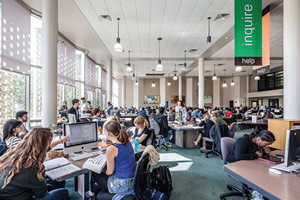Get Smart

PHOTO COURTESY OF RON SCHEFFLER FOR MCMASTER UNIVERSITY
How connected are you to social media? Whether you rarely tweet your thoughts or obsessively
post and hashtag every move, social media opens a
portal between your life and your followers. The same could be
said for smart building controls, where alerts and notifications
shine a light on a structure’s issues.
With the almost universal acceptance of mobile devices and
connectivity, the future of building management looks a lot like
the back and forth on social media. Is the personal interaction
between facility managers and building systems — social media
for buildings — the future of building controls?
Controls, of course, have been around for quite some time.
The connection between building systems and facility professionals
allows for impressive savings. “Statistically, 50 percent
of the energy consumed in a commercial facility is used by
the HVAC system,” reports Brent S. Bernardi, president, Alpha
Controls & Services in Rockford, IL. (Alpha Controls is a member
of the Inside IQ Building Automation Alliance, an international
alliance of independent building automation contractors.) “You
can see anywhere between 7 to 20 percent improvements by putting
basic conservation like proactive monitoring of CO2 and air
quality into play.”
Saving More Than Energy
Bernardi estimates that controls have been commonplace for
“the last 15 years or so.” What’s new in this space is the granularity
of the incoming information and the way administrators are using
it to drive further savings. “Universities are holding individual
colleges fiscally responsible for their energy consumption,” he
says. “This creates awareness, responsibility and accountability.”
Bernardi has been seeing this trend really take hold over the last
two to three years as people become more knowledgeable and
comfortable with technology.
Of course not all schools are created equally. Bernardi admits
that some colleges have more savings opportunities than others. A
research facility, for example, with lots of outside air exchanges, has
a greater opportunity for energy savings than a college of business.
But a robust and responsive conversation between building systems
and facility professionals will garner savings in any setting.
So what does that back and forth look like? Imagine a scenario
where a room temperature is out of range from its classified set
point, or a piece of equipment that’s supposed to be on isn’t. An
alert, like a text or email, would tell the facility professional that
there is a specific problem in a specific place. That professional
would then go into their phone, tablet, laptop or desktop to access
a graphic image of that equipment. “They can do a diagnostic from
there, find the potential failure and send a well-informed service
team out to address the problem,” says Bernardi.
Bernardi advises that the graphic screens are easily viewable
and manipulated on mobile devices to best take advantage of
this technology. “Historically this was viewed on desktops and
laptops,” he says.
While he admits that this is basically tweaking old technology,
Bernardi points to some exciting new changes coming down the pike.
“Building analytics will allow you to quantify the financial impacts of
not making a repair,” he says. “I call it your 24/7 energy manager.”
For example, imagine you have a leaking valve. Fixing it would
mean draining the system and interrupting operations, which
might not make a lot of sense. Now imagine that your building
analytics system told you that not fixing the valve would end up
costing an extra $17,000 in energy. Suddenly fixing it makes a
whole lot of sense.
“It’s a powerful system and more colleges are embracing it,” he
explains.
Look Up
Lighting controls have been around for a long time, but a new
system called Digital Ceiling from Cisco hopes to disrupt the whole
genre and bring the Internet of Things to college campuses. “This
is a big opportunity to open up the tech landscape,” says John
Baekelmans, CTO Vertical Solutions, Cisco.
The Digital Ceiling links building services on a single IP network.
The ultimate goal is to connect lighting, climate control,
security and more through the system. This will improve energy
management by taking advantage of the granular energy information,
common control, analytics and integration capabilities
of the system.
Cisco is partnering with different companies to make this goal a
reality. Right now, however, the Digital Ceiling works with lighting as
Cisco and a variety of LED lighting providers are working together.
The platform allows schools to do some pretty cool things like “tune”
the light color to improve student focus throughout the day.
Baekelmans admits that adoption of this nascent technology
will come down to cost. “All of this sounds sexy but people want to
know what it will bring to the bottom line,” he says. A white paper
put out by the company predicts that the system will yield major
cost savings through daylight harvesting, automatic dimming controls
and presence-based lighting. The Mobile, AL, Public School
System reports a 50 percent reduction in utilities bills since installing
the technology.
While still on the bleeding edge, Digital Ceiling and similar
systems are a technology to watch. “It will provide a huge opportunity
for facility managers to optimize energy efficiency and user
experience,” says Baekelmans.
This article originally appeared in the issue of .